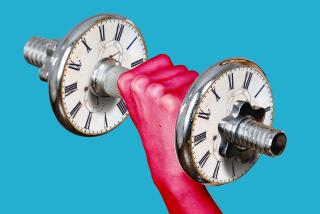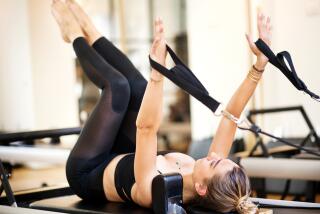Frustrated by Yoga? You’re Not Alone
People who are interested in fitness and health naturally ask a lot of questions. So, for this week’s column, I’m making an overdue trip to the mailbag.
* Joan Andrews of Costa Mesa asked: “What’s up with yoga? Every time I try it, I either get bored with the simple moves or frustrated with the more complex ones. And I never feel that ‘inner peace’ I hear people talking about. Is it just me?”
I wouldn’t say it’s you, because I’ve heard this complaint before. The problem may be your expectations; maybe you’re expecting instant nirvana. Yoga doesn’t work that way. But then again, neither does tennis, for example. You don’t really expect to whack the ball like Chris Evert after a few lessons, do you?
I do, however, suggest that you experiment with different styles of yoga until you find one that feels right. Iyengar yoga, which is pretty popular right now, involves getting into a pose and holding it for at least a minute. Ashtanga, a form of yoga in which you move quickly between poses, is more powerful and athletic. Hybrid forms of yoga combine these two styles (it seems there are as many styles as there are teachers). No matter which one you choose, it’s important to take a beginner’s class, since the poses rely on a solid foundation as they achieve greater complexity.
Even after 20 years of yoga, I still find it challenging. That’s why I encourage you to stick with it. I know that it’s made me calmer, more patient and more alert--as well as more fit. Believe me, once you find a style that appeals to you or an instructor who inspires you, you won’t be bored.
* Steven Patrick of Santa Barbara wondered: “Is it true that you gain weight if you increase your muscle mass?”
Probably yes. But keep in mind that the weight, in and of itself, means nothing. On an ounce-for-ounce basis, muscle weighs more than fat. It is also less bulky. So though you may gain a few pounds as you continue your strength-training program, you’ll actually be losing inches.
I know people who started lifting weights, and within a few months of a regular routine hadn’t lost a single pound but had dropped four dress sizes. The reason is that muscle tissue consumes more energy than fat, so greater muscle mass means a higher metabolism. Which translates to more calories burned every single day, even if your activities don’t change. That’s why weight training is so critical to long-term weight management.
* Lisa McKinley of Minneapolis asked: “Five days a week I either walk or jog. And even though I stretch beforehand, I can’t seem to loosen up my calves and ankles. Can you help?”
Let me offer two tips. First, try this stretch: Stand with your feet hip-width apart, roll up on to your tiptoes and hold for a count of two, then roll back onto your heels and hold for two. Repeat the sequence three times, then find a wall or pole to lean against. Lift one leg off the ground and draw circles with it for 20 seconds; repeat with other leg. You can do either or both stretches while on a walk or a jog if your calves tighten up.
My second tip is to consider the old medical student’s song: “The knee bone’s connected to the leg bone, the leg bone’s connected to the ankle bone, the ankle bone’s connected to the foot bone. . . .” In other words, everything connects to everything else, and your warmups are probably focused too specifically on your calves. Instead, try working every muscle group, beginning with your feet. By the same token, a yoga class once a week or just stretching every single muscle group should help a lot. Improved flexibility everywhere else will no doubt improve your calves too.
* Today’s last question was sent in by Karen Florence of Phoenix: “I just began a walking program, and I’m wondering whether it’s better to take small steps or long strides.”
Keeping to a natural stride helps you to maintain a fluid, rhythmic motion, and it prevents you from bobbing up and down; not only is that a waste of energy, it can cause a sore back and hips. Gauge your natural stride by standing up straight with your feet a few inches apart. Then lean forward from your ankles. As you start to fall, one leg will automatically come forward to stop you. The distance between where it lands and your other foot defines your natural stride.
Thanks to all my correspondents. Keep those cards and letters coming.
Copyright 1999 by Kathy Smith
Kathy Smith’s fitness column appears weekly in Health. Reader questions are welcome and can be sent to Kathy Smith, Health, Los Angeles Times, Times Mirror Square, Los Angeles, CA 90053. If your question is selected, you will receive a free copy of her book “Getting Better All the Time.” Please include your name, address and a daytime phone number with your question.


